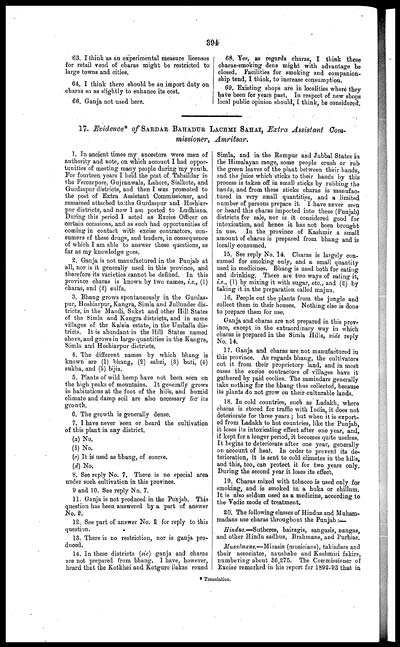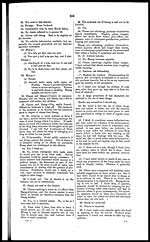Medicine - Drugs > Report of the Indian Hemp Drugs Commission, 1894-1895 > Volume V
(414) Page 394
Download files
Individual page:
Thumbnail gallery: Grid view | List view

394
63. I think as an experimental measure licenses
for retail vend of charas might be restricted to
large towns and cities.
64. I think there should be an import duty on
charas so as slightly to enhance its cost.
66. Ganja not used here.
68. Yes, as regards charas, I think these
charas-smoking dens might with advantage be
closed. Facilities for smoking and companion-
ship tend, I think, to increase consumption.
69. Existing shops are in localities where they
have been for years past. In respect of new shops
local public opinion should, I think, be considered.
17. Evidence* of SARDAR BAHADUR LACHMI SAHAI, Extra Assistant Com-
missioner, Amritsar.
1. In ancient times my ancestors were men of
authority and note, on which account I had oppor-
tunities of meeting many people during my youth.
For fourteen years I held the post of Tahsildar in
the Ferozepore, Gujranwala, Lahore, Sialkote, and
Gurdaspur districts, and then I was promoted to
the post of Extra Assistant Commissioner, and
remained attached to the Gurdaspur and Hoshiar-
pur districts, and now I am posted to Ludhiana.
During this period I acted as Excise Officer on
certain occasions, and as such had opportunities of
coming in contact with excise contractors, con-
sumers of these drugs, and traders, in consequence
of which I am able to answer these questions, as
far as my knowledge goes.
2. Ganja is not manufactured in the Punjab at
all, nor is it generally used in this province, and
therefore its varieties cannot be defined. In this
province charas is known by two names, i.e., (1)
charas, and (2) sulfa.
3. Bhang grows spontaneously in the Gurdas-
pur, Hoshiarpur, Kangra, Simla and Jullunder dis-
tricts, in the Mandi, Suket and other Hill States
of the Simla and Kangra districts, and in some
villages of the Kalsia estate, in the Umballa dis-
tricts. It is abundant in the Hill States named
above, and grows in large quantities in the Kangra,
Simla and Hoshiarpur districts.
4. The different names by which bhang is
known are (1) bhang, (2) sabzi, (3) buti, (4)
sukba, and (5) bijia.
5. Plants of wild hemp have not been seen on
the high peaks of mountains. It generally grows
in habitations at the foot of the hills, and humid
climate and damp soil are also necessary for its
growth.
6. The growth is generally dense.
7. I have never seen or heard the cultivation
of this plant in any district.
(a) No.
(b) No.
(c) It is used as bhang, of course.
(d) No.
8. See reply No. 7. There is no special area
under such cultivation in this province.
9 and 10. See reply No. 7.
11. Ganja is not produced in the Punjab. This
question has been answered by a part of answer
No. 2.
12. See part of answer No. 2 for reply to this
question.
13. There is no restriction, nor is ganja pro-
duced.
14. In these districts (sic) ganja and charas
are not prepared from bhang. I have, however,
heard that the Kotkhai and Kotguro ilakas round
Simla, and in the Rampur and Jubbal States in
the Himalayan range, some people crush or rub
the green leaves of the plant between their hands,
and the juice which sticks to their hands by this
process is taken off in small sticks by rubbing the
hands, and from these sticks charas is manufac-
tured in very small quantities, and a limited
number of persons prepare it. I have never seen
or heard this charas imported into these (Punjab)
districts for sale, nor is it considered good for
intoxication, and hence it has not been brought
in use. In the province of Kashmir a small
amount of charas is prepared from bhang and is
locally consumed.
15. See reply No. 14. Charas is largely con-
sumed for smoking only, and a small quantity
used in medicines. Bhang is used both for eating
and drinking. There are two ways of eating it,
i.e., (1) by mixing it with sugar, etc., and (2) by
taking it in the preparation called majun.
16. People cut the plants from the jungle and
collect them in their houses. Nothing else is done
to prepare them for use.
Ganja and charas are not prepared in this prov-
ince, except in the extraordinary way in which
charas is prepared in the Simla Hills, vide reply
No. 14.
17. Ganja and charas are not manufactured in
this province. As regards bhang, the cultivators
cut it from their proprietory land, and in most
cases the excise contractors of villages have it
gathered by paid coolies. The zamindars generally
take nothing for the bhang thus collected, because
its plants do not grow on their culturable lands.
18. In cold countries, such as Ladakh, where
charas is stored for traffic with India, it does not
deteriorate for three years; but when it is export-
ed from Ladakh to hot countries, like the Punjab,
it loses its intoxicating effect after one year, and,
if kept for a longer period, it becomes quite useless.
It begins to deteriorate after one year, generally
on account of heat. In order to prevent its de-
terioration, it is sent to cold climates in the hills,
and this, too, can protect it for two years only.
During the second year it loses its effect.
19. Charas mixed with tobacco is used only for
smoking, and is smoked in a huka or chillum.
It is also seldom U6ed as a medicine, according to
the Vedic mode of treatment.
20. The following classes of Hindus and Muham-
madans use charas throughout the Punjab:—
Hindus.—Sutheres, bairagis, sangasis, nangas,
and other Hindu sadhus, Brahmans, and Purbias.
Musalmans.—Mirasis (musicians), takiadars and
their associates, naushahe and Kashmiri fakirs,
numbering about 36,275. The Commissioner of
Excise remarked in his report for 1892-93 that in
* Translation.
Set display mode to: Large image | Zoom image | Transcription
Images and transcriptions on this page, including medium image downloads, may be used under the Creative Commons Attribution 4.0 International Licence unless otherwise stated. ![]()
| India Papers > Medicine - Drugs > Report of the Indian Hemp Drugs Commission, 1894-1895 > Volume V > (414) Page 394 |
|---|
| Permanent URL | https://digital.nls.uk/75122073 |
|---|
| Description | Volume 5: Evidence of witnesses from North-Western Provinces and Oudh and Punjab. Answers from witnesses in North-Western Provinces, Oudh and Punjab about cultivation and growth of hemp, preparation or manufacture, trade, consumption or use, effects, administration - taxation and control. |
|---|---|
| Attribution and copyright: |
|




